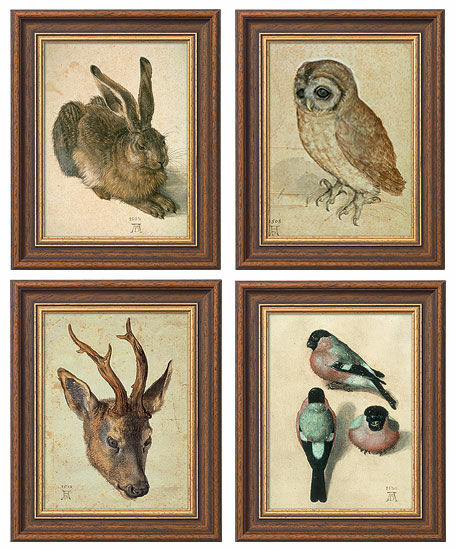Set of 4 animal pictures, framed
Set of 4 animal pictures, framed
Quick info
reproductions on Chagall Insize paper | framed | glazed | size 30 x 24 cm (h/w) each
Detailed description
Set of 4 animal pictures, framed
Albrecht Dürer's close look at the animal world: Dürer is one of the most important and versatile artists of the period of transition from the late Middle Ages to the Renaissance in Germany. His animal drawings, in particular, point to the view of nature, undistorted by mythology and superstition, that became so characteristic of the Renaissance - they can hardly be surpassed in their accuracy of observation and execution of drawing.
"Young Brown Hare (1502): This watercolour is one of Dürer's most famous animal studies. The original is in the Albertina Graphic Collection, Vienna.
"Little Owl" (1508): Original: Watercolour, Albertina Graphic Collection, Vienna.
"Head of a Roebuck" (1514): Original: Watercolour, Musée Bonnat, Bayonne.
"Bird in Three Positions" (1520): Original: Watercolour, Escorial, Madrid.
The watercolours are reproduced on Chagall Insize paper and framed in sophisticated solid wood, glazed. Size 30 x 24 cm (h/w) each.
All four pictures in a set.
This set contains the following products

About Albrecht Dürer
1471-1528
German painter, copperplate engraver and woodcut draughtsman. He is one of the most important and versatile artists of the period of transition from the late Middle Ages to the Renaissance in Germany.
At first, he learned goldsmithing but at the age of fifteen, he already started as an apprentice to a painter. Later he followed the German custom of taking Wanderjahre (gap years), and when he returned home he developed the greatest versatility in painting using the techniques known at the time.
His animal drawings, that are produced in such accuracy of observation and execution of drawing, point to the view of nature, undistorted by mythology and superstition, that became so characteristic of the Renaissance. The statement formulated by Galileo more than a century later already applied to Dürer at his time: "Nature is written in that great book whichever is before our eyes but we cannot understand it if we do not first learn the language and grasp the symbols in which it is written."
(Rebirth). The term describing art from around 1350 until the 16th century.
A mindset that developed in Florence in the late 14th century that was retrospectively classified as rebirth of the classical ideals of Greek and Roman antiquity. During the 15th and 16th centuries, the Renaissance spread first over Italy and then all over Western Europe and determined the entire artistic creation. Brilliant artists such as Donatello, Leonardo da Vinci, Michelangelo, Raphael, Dürer, Holbein, Cranach and Fouquet created their immortal works by following the humanistic premises and placing the human being in the centre of all thinking.
Renaissance experienced its heyday in literature through dramatic works and poems of William Shakespeare.
At the end of the 16th century, the Renaissance had to give way to the opulence of baroque, before its ideas experienced a rebirth in the classicism of the 18th century.






